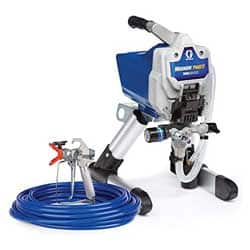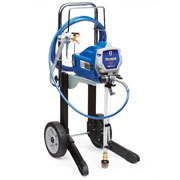Best Epoxy Paint Sprayer — Buyer’s Guide, How To, Reviews, and Comparisons
Epoxy paint sprayers remove the hassle associated with working with this high-density coating. The best sprayers for epoxy provide enough power that it feels like you’re just laying down a regular paint. Look for a unit with a long hose so you can easily reach all the corners.
- 3300 psi operating pressure.
- 0.54 gallons per minute (gpm) output.
- 517 fluid nozzle.
- 50-foot hose.
Epoxy Paint Sprayer Comparison Table
| IMAGE | PRODUCT | DETAILS | ||
|---|---|---|---|---|
|
Best Overall Epoxy Paint Sprayer 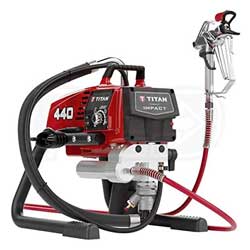
|
Best Overall Epoxy Paint Sprayer
|
Features
|
Check Price at Amazon Titan 440 Impact Review Titan 440 Impact Review | |
|
Best Value for Money Epoxy Sprayer 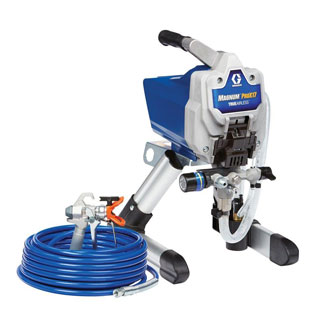
|
Best Value for Money Epoxy Sprayer
|
Features
|
Check Price at Amazon Graco Magnum ProX17 Review Graco Magnum ProX17 Review | |
|
Best for Reduced Overspray 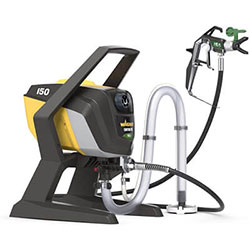
|
Best for Reduced Overspray
|
Features
|
Check Price at Amazon Wagner Control Pro 150 Review Wagner Control Pro 150 Review | |
|
Best for Rental Businesses 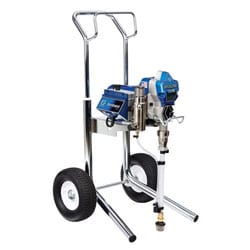
|
Best for Rental Businesses
|
Features
|
Check Price at Amazon Graco RentalPro 230 Review >Graco RentalPro 230 Review | |
|
Most Versatile 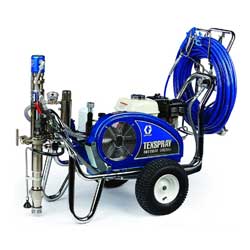
|
Most Versatile
|
Features
|
Check Price at Amazon Graco GH 230 Review Graco GH 230 Review | |
|
Best for Efficiency 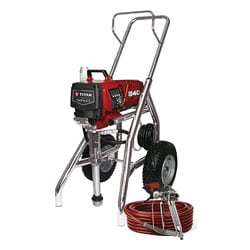
|
Best for Efficiency
|
Features
|
Check Price at Amazon Titan Impact 840 Review Titan Impact 840 Review |
Epoxy Paint Sprayer Buying Guide
- A high operating pressure.
- Airless technology.
- An appropriately sized fluid tip.
- A lengthy hose.
What Is Epoxy Paint Used For?
This two-part resin and hardener substance is used to create a robust, moisture-resistant finish on many different surfaces — think decks, kitchen counters, and most commonly, floors.
It is also available as a one-part formula (pre-mixed if you like) which contains both epoxy and acrylic. This version has the benefit of drying like regular paint and permits color customizations. Yet it still keeps the advantages of being resistant to solvents and chipping.
It’s often thought that epoxy can’t be sprayed, that it has to be poured and smoothed in a laborious procedure, which puts many DIYers off the idea immediately. But this is simply not true. With the best epoxy spray gun, the entire process is relatively headache-free and leaves a more professional-looking result.
How To Choose the Best Epoxy Paint Sprayer
Hose Length
A long hose that maintains a consistent spraying pressure is extremely beneficial so you can reach the outer edges of your projects easily.
Technology

Pressure Output

Nozzle Size
However, as life is not always simple, spray gun manufacturers often use their own nomenclature to express tip sizes. Most consist of three digits, for example, 517.
In this instance, the first digit determines the width of the pattern in inches if you multiply it by two. The last two digits indicate the width of the opening in inches.
For example, on a 517 nozzle, the width of the spray pattern is 10-inches and the opening is 0.017-inches.
Easy to Clean
Many epoxy resin sprayers have revolutionary cleaning systems that allow you to flush the unit fully. On others, you can disassemble the parts making clean-up much easier.
How To Use an Epoxy Paint Sprayer
What You Will Need to Follow This Tutorial
Because epoxies can set extremely fast, make sure you have everything to hand before you start.
- Epoxy paint sprayer
- Epoxy coating (one or two parts as you prefer).
- Correctly sized fluid nozzle.
- Mixing bucket.
- Stir sticks.
- Small paintbrush.
- A helpful assistant.
- Pressure washer or hose and broom.
- Old clothes or coveralls and shoes.
- Goggles, gloves, and an air-supplied respirator.
How To Spray Epoxy Coating on a Garage Floor: A Step by Step Guide
Step 1: Prepare Your Floor
- Move any objects on your floor out of the way — preferably to a completely different area. You need to work at a fair rate and don’t want to interrupt your stride to move items from one place to another.
- Give the floor a thorough clean. Ideally with a pressure washer as it blasts debris off the surface and rinses simultaneously. Allow ample time for the floor to dry and complete a final inspection to ensure that all detritus is removed.
- Don your personal protective gear to ensure that you don’t become the recipient of accidental coating splashes. If using an assistant, make sure they are kitted out too. Because many epoxies are solvent-based, there is an added health risk involved in spraying this substance, so it’s always best to use an air-supplied respirator.
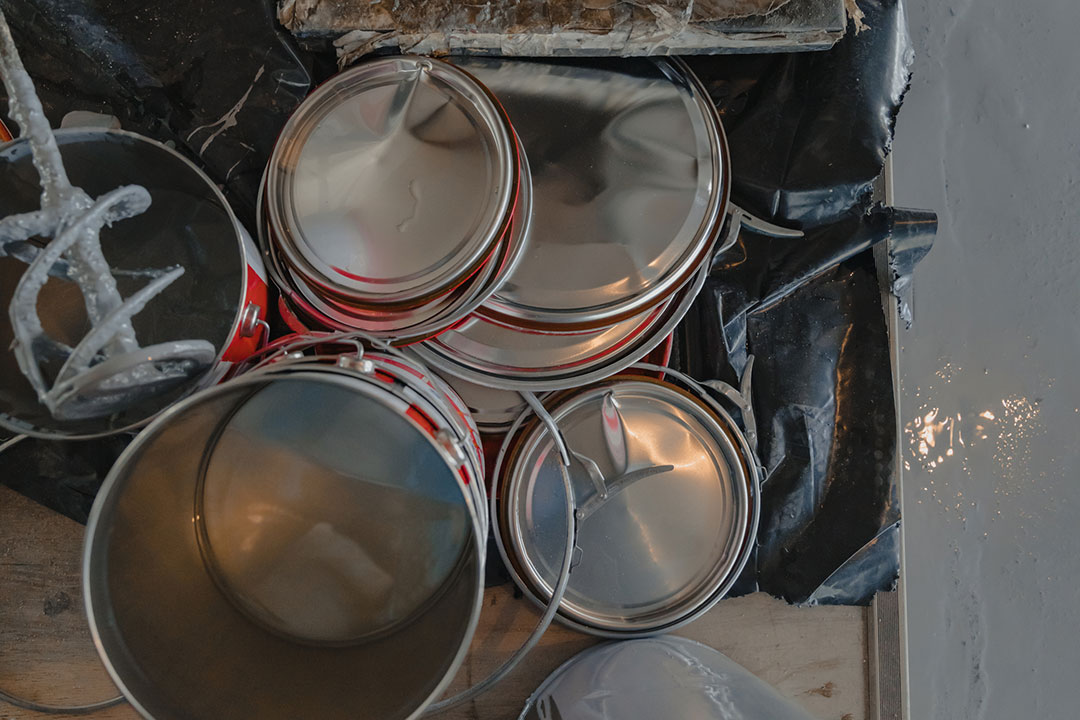
Step 2: Start Spraying
- Set up your epoxy primer spray gun following the manufacturer’s recommendations for pressure settings and speed. Many user manuals come with a quick setup guide, just for this reason. Install the correct nozzle.
- Brief your assistant on what is required of them before you start work. But why do you need an assistant? As epoxy is an exothermic substance, it heats and cures at an impressive rate.
Unfortunately, airless sprayers also generate some heat which can expedite this process — meaning the epoxy could set in the machine or the bucket. To avoid this, avoid exposing too much of the medium to air at one time.
It needs to be an altogether fluid experience — with your assistant mixing at the same rate as you spray.
- When both parties are clear on what is going to happen, have your assistant mix and load the spray gun with the first batch of epoxy. For the best results on mixing, refer to the individual coating manufacturer’s recipe.
- Keep the nozzle between 12 and 18 inches away from the floor’s surface and spray in long, even strokes. Aim to lay down around 0.40-inch thick strokes in each pass. Adjust the distance between your tip and the floor until this is achieved — closer for a thicker layer and vice versa.
If your epoxy layer is thicker than 0.40 inches, you may experience some sagging, which leads to an uneven finish.
- Keep spraying until the floor’s entire surface is coated. With you and your assistant operating like a well-oiled machine with regard to refills.
- For curing time guidelines and the number of required coats, refer to the coating manufacturer’s instructions. Allow to dry completely.
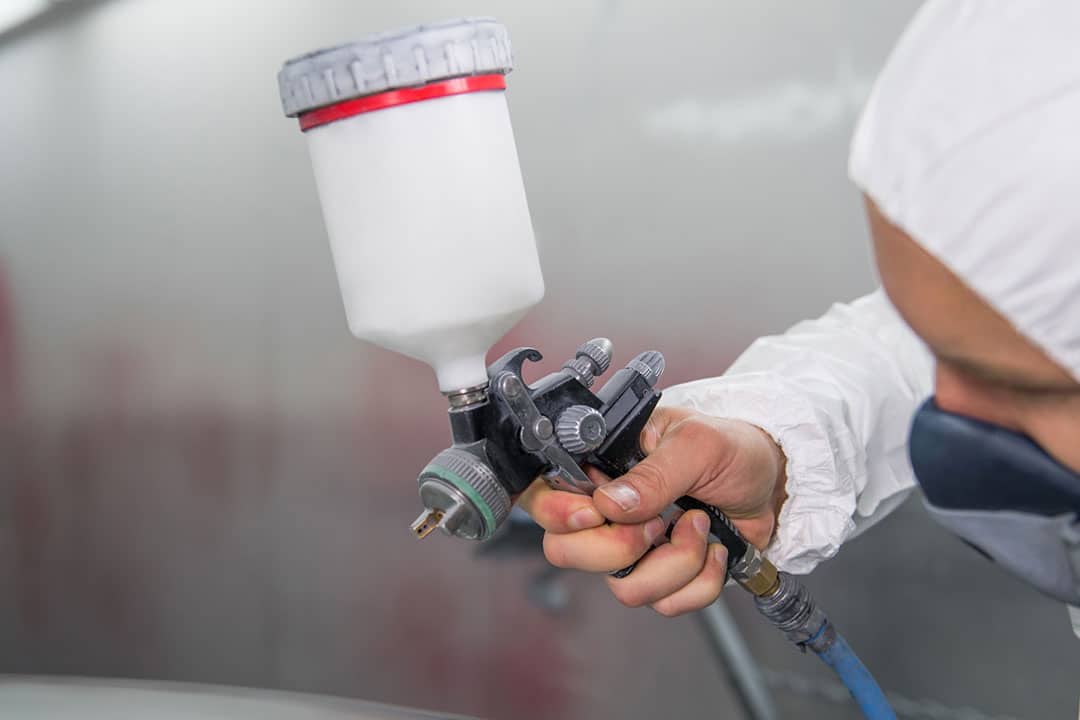
Step 3: Cleaning Up
- As soon as you have finished spraying, start cleaning the sprayer immediately — don’t procrastinate or grab a cup of coffee first. It’s critical that you do not allow the medium to set in the sprayer.
- Check back on your job the following day for the final results. You may find that some of the coating has settled into the concrete and small touch-ups may be required. Depending on the size, you may find that a small paintbrush will be more than adequate for this job.
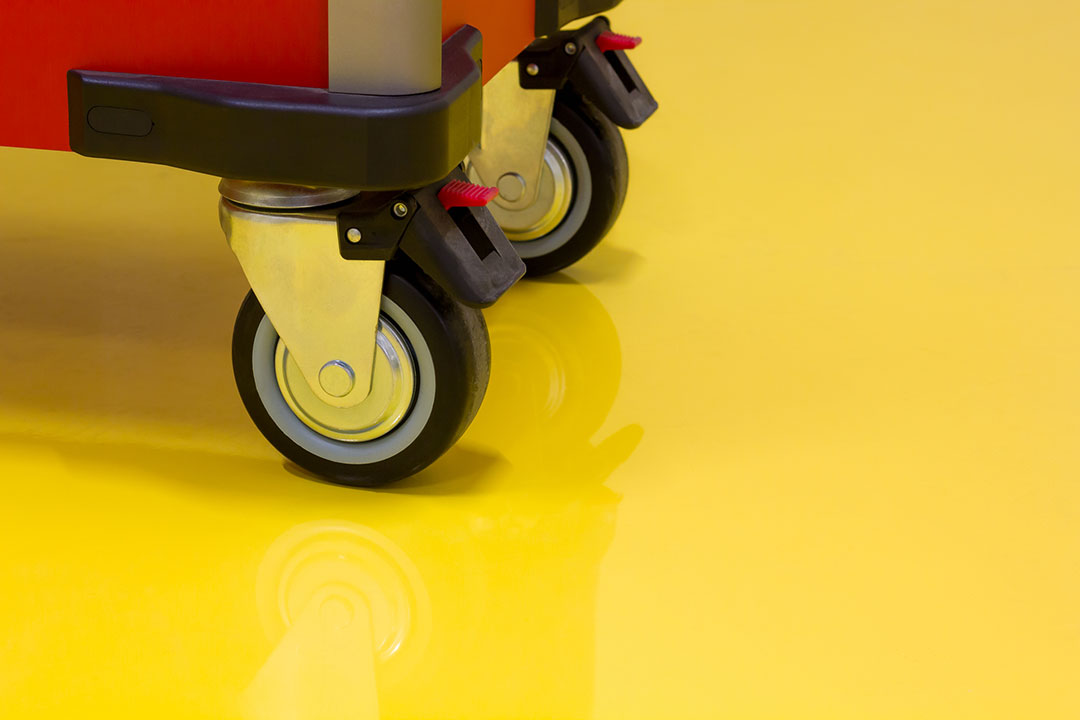
Six First-Rate Epoxy Paint Sprayers
The electric 7/8 horsepower motor provides a monumental 3300 psi of operating pressure, in addition to a substantial flow rate of 0.54 gpm. With a recommended usage of 50 to 70 gallons per week, it should meet many home improvers and contractors’ coating needs.
To reach the far corners of any project, the 50-foot hose should be more than adequate. While clean up can be completed rapidly thanks to the Rapid Clean function.
With just shy of half a century of experience, the Titan Tool name is associated with quality and durability. The sleek red and silver machines pass over frivolous gimmicks — meaning that it’s not a crime to be caught red-handed.
- 3300 psi operating pressure.
- 0.54 gpm output.
- RX-80 spray gun.
- 517 fluid nozzle.
- 50-foot hose.
- Rapid clean function.
- May not have enough grunt for large-scale contracting business needs.
- Design
- Functionality
- Price
The electric 7/8 horsepower motor provides a monumental 3300 psi of operating pressure, in addition to a substantial flow rate of 0.54 gpm. With a recommended usage of 50 to 70 gallons per week, it should meet many home improvers and contractors’ coating needs.
A 517 nozzle is included as standard upon arrival but the RX-80 spray gun can support tips up to 0.023-inches (these are available for extra purchase). Furthermore, the RX-80 includes the bespoke Comfort Grip for an all-around more comfortable spraying experience.
To reach the far corners of any project, the 50-foot hose should be more than adequate. While clean up can be completed rapidly thanks to the Rapid Clean function.
With just shy of half a century of experience, the Titan Tool name is associated with quality and durability. The sleek red and silver machines pass over frivolous gimmicks — meaning that it’s not a crime to be caught red-handed.
- 3300 psi operating pressure.
- 0.54 gpm output.
- RX-80 spray gun.
- 517 fluid nozzle.
- 50-foot hose.
- Rapid clean function.
- May not have enough grunt for large-scale contracting business needs.
- Design
- Functionality
- Price
The flexible uptake hose permits spraying from either a one or five-gallon pail — the former is especially useful when it comes to epoxy. While the stainless steel ProX piston pump eliminates the need to thin most mediums. The pressure is fully adjustable so that you can tailor the output to your job size.
Extra components include a 50-foot flexible hose but if you need, up to an impressive 150-foot can be supported without a loss of pressure. Additionally, the 515 fluid nozzle is reversible, making it simple to remove any frustrating clogs — just rotate it 180 degrees to keep spraying.
Graco Incorporated is now one of the most renowned authorities in the fluid handling industry. Based in the US, this home-grown company is synonymous with quality spraying solutions.
- 515 Switchtip nozzle.
- 50-foot flexible hose.
- Sprays directly from one or five-gallon containers.
- PowerFlush connection to a garden hose for easy cleanup.
- 0.34 gallons per minute flow rate.
- Variable pressure output.
- Could be overkill for small surfaces such as kitchen work surfaces.
- Design
- Functionality
- Price
The flexible uptake hose permits spraying from either a one or five-gallon pail — the former is especially useful when it comes to epoxy. While the stainless steel ProX piston pump eliminates the need to thin most mediums. The pressure is fully adjustable so that you can tailor the output to your job size.
A recommended annual usage of 300 gallons per year should be enough for even the most ardent DIYer.
Extra components include a 50-foot flexible hose but if you need, up to an impressive 150-foot can be supported without a loss of pressure. Additionally, the 515 fluid nozzle is reversible, making it simple to remove any frustrating clogs — just rotate it 180 degrees to keep spraying.
Graco Incorporated is now one of the most renowned authorities in the fluid handling industry. Based in the US, this home-grown company is synonymous with quality spraying solutions.
- 515 Switchtip nozzle.
- 50-foot flexible hose.
- Sprays directly from one or five-gallon containers.
- PowerFlush connection to a garden hose for easy cleanup.
- 0.34 gallons per minute flow rate.
- Variable pressure output.
- Could be overkill for small surfaces such as kitchen work surfaces.
- Design
- Functionality
- Price
The ability to spray up to 175 gallons per year makes this sprayer suitable for the majority of home improvers with a plethora of renovation projects lined up. Furthermore, the 0.55 horsepower pump can cope with many unthinned mediums.
A 515 airless nozzle finely atomizes coating particles to lay down a consistent finish. The 25-foot hose combined with the stationary base offers substantial reach and, at the same time, keeps the weight in your hand to a minimum.
Wagner SprayTech has been operating for around seven decades and is perhaps best known for its HVLP solutions. However, in recent years, it seems to have come into its own and is now manufacturing quality airless spray guns.
- 515 fluid nozzle.
- HEA technology.
- 25-foot hose.
- Variable pressure output.
- 0.29 gallons per minute.
- Operating this spray gun takes a little getting used to.
- Design
- Functionality
- Price
The ability to spray up to 175 gallons per year makes this sprayer suitable for the majority of home improvers with a plethora of renovation projects lined up. Furthermore, the 0.55 horsepower pump can cope with many unthinned mediums.
Speaking of the pump, the entire fluid section can be completely rebuilt in a matter of minutes, increasing the longevity of this unit as well as maximizing uptime. A flow rate of 0.29 gallons per minute makes short work of medium to large jobs.
A 515 airless nozzle finely atomizes coating particles to lay down a consistent finish. The 25-foot hose combined with the stationary base offers substantial reach and, at the same time, keeps the weight in your hand to a minimum.
Wagner SprayTech has been operating for around seven decades and is perhaps best known for its HVLP solutions. However, in recent years, it seems to have come into its own and is now manufacturing quality airless spray guns.
- 515 fluid nozzle.
- HEA technology.
- 25-foot hose.
- Variable pressure output.
- 0.29 gallons per minute.
- Operating this spray gun takes a little getting used to.
- Design
- Functionality
- Price
Arriving in a Hi-Boy cart design, it’s fuss-free to maneuver around job sites and incorporates a 50-foot hose. The 7/8 horsepower motor grants an operating pressure of 3300 psi and a rate of 0.54 gpm — gearing it toward residential and light commercial projects.
On the topic of maintenance, the Endurance pump is easy to change out and can be completed in three simple steps. While the Power Flush, QuikAccess, and Easy Out filter features make short work of necessary servicing and cleaning.
As a market leader in the world of paint spraying, Graco has been in operation for several decades. This brand is well known for its state-of-the-art technology combined with innovation and exemplary customer service.
- Power Flush garden hose adaptor.
- 3300 PSI operating pressure.
- 515 fluid nozzle.
- 50-foot hose.
- FTx spray gun.
- 7/8 horsepower DC motor.
- High-boy configuration is not the easiest to transport between jobs.
- Design
- Functionality
- Price
Arriving in a Hi-Boy cart design, it’s fuss-free to maneuver around job sites and incorporates a 50-foot hose. The 7/8 horsepower motor grants an operating pressure of 3300 psi and a rate of 0.54 gpm — gearing it toward residential and light commercial projects.
The FTx spray gun is fitted with a 515 airless tip which operates well with a range of mediums. Additionally, a digital display shows hourly usage tracking of and delivers reminders when regular maintenance should be completed.
On the topic of maintenance, the Endurance pump is easy to change out and can be completed in three simple steps. While the Power Flush, QuikAccess, and Easy Out filter features make short work of necessary servicing and cleaning.
As a market leader in the world of paint spraying, Graco has been in operation for several decades. This brand is well known for its state-of-the-art technology combined with innovation and exemplary customer service.
- Power Flush garden hose adaptor.
- 3300 PSI operating pressure.
- 515 fluid nozzle.
- 50-foot hose.
- FTx spray gun.
- 7/8 horsepower DC motor.
- High-boy configuration is not the easiest to transport between jobs.
- Design
- Functionality
- Price
The Heavy-Duty Texture spray gun handles highly viscous coatings effortlessly but, at the same time, is comfortable to hold. There’s also a cooling system installed in this machine for cooler operation, which is especially useful when working with epoxy.
Additionally, there are two BlueMax II hoses included (one 50-foot and one 3-foot, for those smaller tasks). While the Silver Plus spray gun comes complete with a reversible 517 nozzle and guard.
Graco products rate very highly with dedicated DIYers and professionals alike due to unmatched durability and reliability. A US-based company that came from humble beginnings, Graco is a true market leader.
- 3 and 50-foot hoses.
- Silver Plus airless spray gun.
- 3300 psi max pressure.
- Can operate under gas or electric power.
- Inbuilt cooling system.
- Could be over-specced for occasional users.
- Design
- Functionality
- Price
The Heavy-Duty Texture spray gun handles highly viscous coatings effortlessly but, at the same time, is comfortable to hold. There’s also a cooling system installed in this machine for cooler operation, which is especially useful when working with epoxy.
This device is powered by a 200 cc Honda engine and runs at an impressive 6.5 horsepower. Furthermore, coating build-up is eliminated within the machine with the self-cleaning Vibra-Seal and Maxflo 2 systems.
Additionally, there are two BlueMax II hoses included (one 50-foot and one 3-foot, for those smaller tasks). While the Silver Plus spray gun comes complete with a reversible 517 nozzle and guard.
Graco products rate very highly with dedicated DIYers and professionals alike due to unmatched durability and reliability. A US-based company that came from humble beginnings, Graco is a true market leader.
- 3 and 50-foot hoses.
- Silver Plus airless spray gun.
- 3300 psi max pressure.
- Can operate under gas or electric power.
- Inbuilt cooling system.
- Could be over-specced for occasional users.
- Design
- Functionality
- Price
This machine is jam-packed with time-saving features, which could look like frivolous gadgets to the untrained eye. But those in the know will definitely appreciate them. Starting with the 2.3 horsepower brushless motor, an impressive amount of power and pressure is driven out — up to 3300 PSI.
The RX Pro spray gun has the option of a two or four-finger trigger, as well as incorporating a swivel connection into its design — which helps to keep kinks out of the 50-foot hose when moving around.
Furthermore, the 517 fluid tip is great for handling most coatings. Should you need, a second spray gun can be attached, allowing two operators to work at one time.
Titan Tools has been in business for over forty years and continues to make continual advancements to its technologies. Titan machines are found in workshops globally — a true sign that it’s a current industry leader.
- DigiTrac diagnostic display.
- 2.3 horsepower brushless motor.
- 50-foot hose.
- Multi-gun operating capacity.
- 3300 psi operating pressure.
- Relatively high price point.
- Design
- Functionality
- Price
This machine is jam-packed with time-saving features, which could look like frivolous gadgets to the untrained eye. But those in the know will definitely appreciate them. Starting with the 2.3 horsepower brushless motor, an impressive amount of power and pressure is driven out — up to 3300 PSI.
A proprietary DigiTrac display offers real-time analysis of operating pressure and reminds you when it’s time comes routine servicing — providing you set the timer! There’s also Titan’s AutoOiler function which allows you to grease the Quad+ packings with just a push of a button — no extra oil can is needed here.
The RX Pro spray gun has the option of a two or four-finger trigger, as well as incorporating a swivel connection into its design — which helps to keep kinks out of the 50-foot hose when moving around.
Furthermore, the 517 fluid tip is great for handling most coatings. Should you need, a second spray gun can be attached, allowing two operators to work at one time.
Titan Tools has been in business for over forty years and continues to make continual advancements to its technologies. Titan machines are found in workshops globally — a true sign that it’s a current industry leader.
- DigiTrac diagnostic display.
- 2.3 horsepower brushless motor.
- 50-foot hose.
- Multi-gun operating capacity.
- 3300 psi operating pressure.
- Relatively high price point.
- Design
- Functionality
- Price
Conclusion
It should have a significant pressure output to finely atomize the coating quickly before it has a chance to cure. It should also be fast and easy to clean for the same reason, so any quick clean features installed are a bonus.
An adequate hose length should be provided to enable reach from one side to another without interruptions that can impact the quality of your finish. Furthermore, the fluid nozzle should be sized for epoxy.
With all this in mind, I wish you happy spraying with your new epoxy paint sprayer.
Epoxy Paint Sprayer FAQs
Q: Can You Use Epoxy Paint in a Spray Gun?
One question we get asked a lot at Tool Nerds is “can epoxy be sprayed?” Contrary to popular belief, you can use epoxies in a paint sprayer. But you need to stay on your toes more than when operating with other paints. If you are not sure where to get started, take a look at my helpful how-to guide above.
Q: Is Epoxy Primer Safe To Spray?
Some people say it is perfectly safe to spray epoxy primer while others say it’s not a good idea. To spray epoxy primer, you will need to follow a few safety standards. Make sure your workspace is well ventilated and you are wearing goggles and an air-supplied respirator.
Q: Does Epoxy Primer Shrink?
There may be a little shrinkage when working with epoxy primers. However, it should not be sufficient to disturb the integrity of the coating.
Q: Is Epoxy Primer Waterproof?
Yes, it is and this is why epoxy is often touted as the perfect solution for floors, especially in areas prone to accidental spillages, such as garage floors.
Q: Does Epoxy Primer Need To Be Sanded?
It depends on the surface you’re spraying. But as a general rule, I would say you don’t. Especially if it has been applied with an epoxy sprayer, as the surface should not contain many imperfections.
Q: Can You Apply Epoxy Over Paint?
Yes, you can. You may even find that it brings out the best results to the paint by adding a high gloss sheen that makes any colored coat pop.


